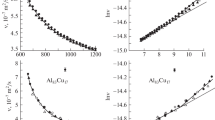Abstract
In order to investigate the mechanism by which electromagnetic vibrations affect the solidification structure of metallic alloys, an experimental apparatus which enables the simultaneous application of electric and magnetic fields under different cooling conditions (ranging from rapid to furnace cooling) is developed. The objective is followed by inducing vibrations in a hypereutectic Al-Si alloy melt containing suspended silicon particles and interrupting the process at different temperatures before and after the start of solidification by water quenching. Interrupting the process at temperatures higher than the liquidus has revealed the effects of vibrations independent of the influences of the nucleation and growth phenomena. Establishing the conditions for obtaining identical cooling rates in experiments with different experimental conditions has lead to the exclusion of effects resulting from the differences in cooling rates and recognition of the effects caused only by electromagnetic vibrations. It is found that the application of either of the two fields alone has no significant effect on the solidified structure, while profound effects are observed when the two fields are applied simultaneously. An increase in the number of suspended silicon particles and a reduction in their average size are the effects noticed before the start of solidification. In this research, it has for the first time been clearly verified, through microscopic observation of the quenched samples, that these effects are brought about by the cavitation phenomenon. After the start of solidification, particles are locally agglomerated and expelled toward the surrounding walls under a combined influence of electromagnetic vibrations and pinch force squeezing the liquid. The final structure obtained is composed of an almost completely eutectic matrix surrounded by agglomerates of silicon particles along the outer surface.
Similar content being viewed by others
References
S. Asai: Iron Steel Inst. Jpn. Int., 1989, vol. 29 (12), pp. 981–92.
C. Vives: Metall. Mater. Trans. B, 1996, vol. 27B, pp. 457–64.
C. Vives: Mater. Sci. Eng., 1993, vol. A173, pp. 169–72.
O. Abramov: Ultrasound in Liquid and Solid Metals, CRC Press, Boca Raton, FL, 1994, pp. 1029–39.
T. Leighton: The Acoustic Bubble, Academic Press Ltd., London, 1994, pp. 531–51.
K.S. Suslick: Science, 1990, vol. 247, p. 1068.
K.S. Suslick: Application of Ultrasound to Materials Chemistry, MRS Bulletin, Apr. 1995, pp. 29–34.
F. Yamao, K. Sassa, K. Iwai, and S. Asai: Tetsu-to-Hagané, 1997, vol. 83 (1) pp. 30–35.
Author information
Authors and Affiliations
Rights and permissions
About this article
Cite this article
Radjai, A., Miwa, K. & Nishio, T. An investigation of the effects caused by electromagnetic vibrations in a hypereutectic Al-Si alloy melt. Metall Mater Trans A 29, 1477–1484 (1998). https://doi.org/10.1007/s11661-998-0363-z
Received:
Issue Date:
DOI: https://doi.org/10.1007/s11661-998-0363-z




